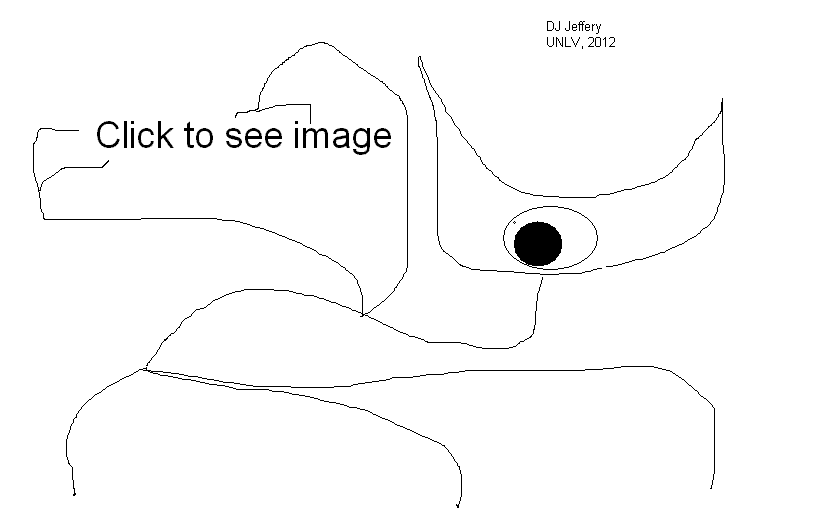-
In the first part of intro astro, we did old astronomy---positions of
astro-bodies, their appearances on the sky
(like the angular diameters
illustrated in the figure above/below,
calendar usage, etc---astronomy
whose inner core goes back millennia.
Then we did a foray into physics.
Now we are ready for new astronomy or astrophysics in which we consider the physical nature of the astro-bodies.
This physical nature must be determined by a combination of observation and modeling.
Actually, a quasi-endless cycle of observation and modeling in order to improve our understanding---the hoary old scientific method, in fact. See figure below (local link / general link: sci_method.html).
We start with the Sun and work outward.
The traditional ordering of topics in intro astro classes---which
IAL mostly follows---is
Sun,
Solar System,
exoplanets (a new addition to the traditional ordering),
stars,
galaxies,
cosmology---farther and farther out---with
a last return to smaller scale for
SETI (Search for Extra-Terrestrial Intelligence).
The figure below
(local link /
general link: cosmos_logarithmic_map_linear.html)
illustrates our journey to
infinity and
eternity.
We primarily focus on what has been determined with only tidbits about the
how---but the tidbits are important too.
-
In this lecture, we consider the Sun as it is today.
See figure below
(local link /
general link: sun_white_light.html).
- The Sun Today:
By considering the Sun today (i.e., at our moment in cosmic time), we are just considering a snapshot in the Sun's lifetime, but its a snapshot that is roughly valid for most of its 10 or 11 Gyr lifetime as a nuclear burning object. (For nuclear burning, see section Nuclear Fusion in the Sun below.)
The Sun age = 4.6 Gyr (set by various methods) (see also Solar System age = 4.5682 Gyr (set by first solids formed in presolar nebula); Wikipedia: Formation and evolution of the Solar System: Timeline of Solar System evolution).
-
We know this age so precisely from radioactive dating which is
a topic we cover in IAL 10: Solar System Formation.
Radioactive dating is a subject less exciting than it sounds.
Stars on the main sequence (of stars) burn hydrogen to helium (in a nuclear burning sense: see section Nuclear Fusion in the Sun below) in their cores and are fairly stable and unchanging.
The main sequence phase of a star is the longest phase of a star's nuclear burning lifetime.
-
Because the main sequence phase is the
longest phase of a star's nuclear burning
lifetime, most
stars we observe in their
nuclear burning lifetimes
are on the main sequence.
The range of star behavior is so broad that the idea of an average star is of little use.
The average star of a particular stellar classification is of use because the stellar classifications are sufficiently narrow in range of behavior.
- The Spectral Classification of the Sun:
temperature sequence in decreasing order.The Sun is, in fact, a G2 V star in the OBAFGKM spectral classification.
-
In the all astronomy and stars and cosmology sequences of
IALs, we
go on to look at
stellar classification
in detail.
- The spectral types
are subdivided into
spectral subtypes
labeled by numbers running 0 through 9.
- There is the Main-sequence rule (local link / general link: star_main_sequence_rule.html):
-
The photosphere is that
layer of a star
from which visible light escapes to infinity---so it's the primary layer that we see.
Hydrogen line strength first increases with photosphere temperature, but then starts decreasing about 10,000 K which is about the highest photosphere temperature of the A star class.
-
Somehow some letters got omitted for good like C, D, H, etc. in the reordering.
The Roman numeral V in the classification G2 V star for the Sun designates the luminosity class (which is shown in the figure above (local link / general link: star_hr_lum.html).
Here it suffices to say that V essentially stands for main sequence.
For more on stellar classification, see Stellar classification videos below.
-
Stellar classification videos
(i.e., Stellar classification
videos):
- Spectrum of the Stars | 0:54: OK, but redundant with lectures.
- The Spectra of Stars (2/2) | 3:46: OK for OBAFGKM, but too longwinded for the classroom.
For some of the spectra of the spectral types, see the figure below (local link / general link: star_spectra.html).
- Magnetic Fields in Astrophysics:
Just to forewarn, many of the Sun's behaviors are magnetic. Sun weather is largely magnetic and Star weather. We can measure the magnetic fields on the Sun using spectroscopy, but we will NOT go into how this is done.
It's also true that other stars must have a lot of magnetic phenomena, but since we do NOT see those other stars close up, we notice their magnetic phenomena far less. They have starspots which are the general category into which fall magnetic fields are extremely important in many fields of astrophysics.
But treating magnetic fields in depth is beyond our scope, and so we just dip a little into magnetic fields where absolutely necessary.
But one key point about magnetic fields to remember at our level is that they cause the magnetic force on charged particles and this causes the charged particles helix along magnetic field lines. The helixing is because the magnetic force acts perpendicularly to the magnetic field lines AND the velocity of the charged particles.
- The Spectral Classification of the Sun:
Later we will consider its birth, evolution, and death in IAL 9: The Life of the Sun.
-
The Sun is a giant ball of hot gas---but
NOT just a giant ball of hot gas.
- Differential Rotation:
The Sun is rotating, but NOT all at the same speed. It is NOT a solid, and so can rotate DIFFERENTIALLY: i.e., it has differential rotation.
-
Actually, the Earth is NOT
completely solid: the
Earth's outer core (radial range ∼ 1220--3480 km)
is molten
and has differential rotation.
For the solar rotation curves deduced from helioseismology, see the figure below (local link / general link: solar_rotation.html).
- Solar Composition, Primordial Solar Nebula Composition, Cosmic Composition:
The Sun is made of matter---no surprise. By the by, matter is usually taken to be stuff with rest mass.
-
Question: What is the most abundant element in the Sun?
Answer 4 is right.Herium (Her) should exist.
- The Composition of the Rocky and Rocky-Icy Bodies in the Solar System:
The composition of the rocky bodies and rocky-icy bodies in the solar system (i.e., Earth, Moon, Mercury, Venus, Mars, moons, and small Solar System bodies (e.g., asteroids, meteoroids, and trans-Neptunian objects)) is much like that of the Sun, except for much smaller amounts of H and He.
The rocky bodies lost or never had much H and He for reasons we will discuss in IAL 10: Solar System Formation.
But note the rocky bodies if they are sufficiently large have undergone planetary chemical differentiation.
The heaviest elements tended to sink.
So most of Earth's iron is in its deep interior. This is a theory, of course. No one's ever sampled there. But it's a well-grounded theory.
We discuss planetary chemical differentiation in IAL 10: Solar System Formation: Chemical Differentiation.
As a preview of planetary chemical differentiation and the 4 stages that rocky-icy bodies TEND to go through (Se-427) are summarized in the cartoon in the figure below (local link / general link: rocky_body_evolution_4_stages.html).
- Plasmas (AKA Ionized Gases):
All stars including the Sun are completely ionized gas (i.e., a gas of bare nuclei and free electrons) in their interior. Their surface regions are less extreme ionized gas.
The physics term of ionized gas is plasma.
Plasmas are explicated in the figure below (local link / general link: plasma.html).
- Basic Solar Parameters:
The figure below (local link / general link: sun_basics.html) gives some basic solar parameters (i.e., controlling variables).
-
Question: What kind of pressure is it in the interior of the Sun?
- Gas pressure of ions and electrons. Essentially their banging around to provide a force similar to air molecules in the Earth's atmosphere.
- Radiation pressure provided by the electromagnetic radiation (EMR).
- Solid pressure such as provided by the Earth's crust, mantle, and inner core.
- 1 and 2.
- 2 and 3.
You'll have to be very brave since we havn't discussed radiation pressure.
Answer 1 is right.Radiation pressure exists and is sometimes very important in astrophysics, but for low mass main-sequence stars, it is close to negligible (Cl-163--165).
Yours truly did NOT expect you to know that, but now you do---even more importantly so does yours truly.
As temperature increases, they increase; as temperature decreases, they decrease.
If the temperature of the Sun were to drop to zero, the Sun would collapse to become a white dwarf which is a star of order Earth size, of enormous density, held up by a quantum mechanical degeneracy pressure of electrons.
Becoming a white dwarf is the ultimate fate of the Sun when it runs of out hydrogen and helium fuel as we will discuss in Intro Astro Lecture 9: The Life of the Sun.
For more on pressure laws of interest in astronomy, see the figure below (local link / general link: gas_classical_quantum.html).
- Solar Composition, Primordial Solar Nebula Composition, Cosmic Composition:
It's more complicated than that.
-
Group Activity:
Form groups of 2 or 3---NOT more---and tackle Homework 8 problems 2--7 on Sun basics---you'll have to look at the section Solar Luminosity and the Solar Constant below to answer some questions.
Discuss each problem and come to a group answer.
Let's work for 5 or so minutes.
The winners get chocolates.
See Solutions 8.
- Electromagnetic Radiation in Space: A Preview of Beyond the Solar System:
Stars are dense in photons relative to space.
So the free flow of photons between the two is overwhelmlingly from stars to space.
In a thermodynamics description, this flow to space increases entropy in obedience to the 2nd law of thermodynamics.
A prime piece of evidence for the comparative low density of photons (i.e., electromagnetic radiation (EMR)) in space is the darkness of the night sky (AKA Olbers' paradox).
But though space is low density in photons, there are photons everywhere at in all observable wavelength bands.
To explicate and as a preview of astronomy beyond the Solar System, the figure below (local link / general link: diffuse_extragalactic_background_radiation.html) explicates the EMR in space that does NOT come directly from resolvable compact sources: i.e., the diffuse extragalactic background radiation (DEBRA).
- Stars Lose Heat Energy to Space:
Because of the net flow of EMR to space, the Sun (and all other stars) are constantly losing heat energy. They radiate it away as EMR.
There are other less-important ways that stars lose energy to space: stellar winds and neutrinos. We will NOT discuss the cause of stellar winds. The flow of neutrinos to space is discussed in subsection Nuclear Burning in Stars and the Sun.
The rate of heat energy outflow in EMR is called luminosity.
For the Sun, the luminosity is the solar luminosity L_☉ = 3.828*10**26 W. Compare that to a 100-watt light bulb.
- Solar Constant:
How much of that energy from the Sun do we get at Earth?
The important parameter is the solar constant which is explicated in the figure below (local link / general link: solar_constant.html).
The figure below illustrates The time variation in the solar constant is illustrated in the figure below (local link / general link: solar_constant_time_plot.html).
- The Secular Increase of the Solar Constant:
In addition to the periodic variation of the solar constant, there are also secular (i.e., long-term) variations.
The most important one is a long-term increase in the solar constant due to a long-term increase in the Sun's luminosity (WB-106). See the figure below (local link / general link: sun_evolution.html).
Alas, the long-term increase spells the doom of life on Earth. But that's a story for another day. See the discussion in IAL 11: The Earth.
- Stars Lose Heat Energy to Space:
-
Group Activity:
Form groups of 2 or 3---NOT more---and tackle Homework 8 problems 2--7 on Sun basics.
Discuss each problem and come to a group answer.
Let's work for 5 or so minutes.
The winners get chocolates.
See Solutions 8.
- The Source of the Sun's Energy:
Since the Sun is emitting EMR, it would cool off relatively rapidly if heat energy (properly internal energy) were NOT continually being resupplied.
The resupply comes from nuclear fusion of hydrogen (H) to helium (He) in the core of the Sun which extends from the center to ∼ 0.2 R_☉. This is illustrated in the figure below (local link / general link: sun_structure_cutaway.html).
- Nuclear Burning:
Note, astrophysicists usually refer to self-sustaining nuclear reaction chains as nuclear burning with it understood that chemical burning is NOT meant.
Both nuclear burning and chemical burning are chain reactions (in a sense) where one reaction provides the heat energy to cause further reactions.
Nuclear reactions are of order 10**6 more energetic than analogous chemical reactions.
That factor of 10**6 has mesmerized people since the discovery of radioactivity in 1896---so much energy from so little fuel.
Nuclear bombs and nuclear reactors have been the upshot.
But though nuclear burning has a very high heat energy output, it has a very high energy threshold to start and maintain chain reactions.
In the Sun, that threshold is met by the Sun's central temperature T = 15.7*10**6 K and central density ρ = 150 g/cm**3 (Cox-342).
Under these temperature and density conditions, the matter is completely ionized: i.e., there are NO electrons bound to nuclei and both nuclei and electrons fly around as free particles.
As we explained above in subsection Plasma (AKA Ionized Gas), this state of matter is an extreme plasma (i.e., a maximally ionized gas).
In the below subsections, we explicate nuclear physics and nuclear burning in stars and the Sun.
- Nuclear Physics:
We need a tiny bit of nuclear physics.
The figure below (local link / general link: ernest_rutherford_lab.html) illustrates where nuclear physics all began.
Protons and neutrons are collectively classed as nucleons.
Nuclei are much smaller than atoms.
-
The atomic size scale is a few angstroms---1
angstrom (Å) = 10**(-10) m---it is the
natural unit of
atoms.
The nuclear size scale is a few fermis---1 fermi (fm) = 10**(-15) m---it is the natural unit of nuclei.
Species with the same number of protons and different numbers of neutrons are isotopes of each other.
In regard to chemical reactions, different isotopes of an atom are nearly identical.
There are minute differences because of the differences in atomic mass.
But in regard to nuclear reactions, the isotopes can be quite different in behavior.
For example, the hydrogen nucleus usually just consists of a single proton. A proton and neutron nucleus is a heavy hydrogen nucleus which has a special name deuteron.
-
Heavy hydrogen itself is called
deuterium.
Actually,
deuterons
and deuterium
are often loosely used as synonyms.
"Stable" in this context means the isotope will NOT spontaneously radioactive decay to a different species.
The He-4 atom and nucleus are illustrated in the figure below (local link / general link: atom_he_4.html).
- The Nuclear Strong Force:
Nuclei are held together against the electric force repulsion of the protons by the strong nuclear force.
The electric force is explicated a bit in the figure below (local link / general link: electric_force_coulombs_law.html).
It acts only over a distance of about 1 fermi (10**(-15) m). Recall 1 fermi is 10**5 times smaller than atom size.
The length range of the strong nuclear force is what sets the size scale of nuclei at about 1 to 10 fermis.
Note, the electric force binds the electrons to the nuclei to make atoms.
The electrons, of course, repel each other by the electric force, but the combination of attraction to the nuclei, repulsion from each other, and quantum mechanics dictates that atoms are stable, but are able to interact with each other in a very complex way that allows chemistry, and thus, life as we know it.
-
It's one of the jillion remarkable facts about the
universe that
the strong nuclear force
allows there to be little packets of varying amounts of
positive charge
(i.e., nuclei).
This fact is a key ingredient in chemistry and thus, life as we know it.
There are cases where electrons do bind with protons to make neutrons: electron capture (an ordinary radioactive decay process) and neutron star formation (an extreme astrophysical process).
- The Weak Nuclear Force:
There are 4 known fundamental interactions (i.e., the four fundamental forces) in physics: gravity, the electromagnetic force, the strong nuclear force, and the weak nuclear force. In a sense, the last 3 are united in the standard model of particle physics (see Wikipedia: Fundamental interaction: The Standard Model). Hopefully, one day gravity (including quantum gravity) will be united with the other 3 in the theory of everything (TOE).
But at the moment, the question is what does the weak nuclear force do?
It transforms protons into neutrons or vice versa in order to stabilize the nucleus. The process is called beta decay. In nuclear burning, beta decay often occurs as part of overall nuclear reactions. Beta decay also happens as relatively isolated events in which case it classified as a form of radioactivity---in fact, the most usual kind of radioactivity.
Beta decay is important in hydrogen burning in stars as we discuss just below in subsection Nuclear Burning in Stars and the Sun.
- Nuclear Burning in Stars and the Sun:
Now H nuclei (which are just single protons usually) strongly repel by the electric force because they are like-charged particles.
In stars, only in the cores is it sufficiently hot and dense that the electric force repulsion can be overcome and the H nuclei can collide closely enough that the strong nuclear force can bind them (i.e., fuse them).
The interaction of protons is somewhat explicated in the figure below (local link / general link: nuclear_burning_pp.html).
But the final product in stellar hydrogen burning is the very stable He-4 nucleus.
There are several H-to-He-4 burning processes in stars. The figure below (local link / general link: nuclear_burning_processes.html) illustrates the two dominant ones: the proton-proton chain reaction and the CNO cycle.
- Star Nuclear Burning is Stable:
Star nuclear burning is STABLE for main-sequence stars and mostly for post-main-sequence stars.
Main-sequence stars (including especially the good old Sun) are NOT just going turn off NOR do a thermonuclear runaway and blow up like a giant bomb.
Post-main-sequence stars do have explosive events due to nuclear burning. For stars that start on the main sequence with mass ⪅ 8 M_☉ , there are thermal pulses (AKA helium shell flashes), that convert them eventually convert the stars into white dwarfs. For stars that start on the main sequence with mass ⪆ 8 M_☉ , they explode as core-collapse supernovae leaving compact remnant neutron stars or black holes.
Also, full thermonuclear runaways do happen in some white dwarfs in peculiar binary star systems or maybe triple star systems (see Kushnir et al.)???---or such is the theory yours truly staked their career on---but thermonuclear runaways to NOT happen in main-sequence stars.
Exploding white dwarfs are Type Ia supernovae (AKA SNe Ia). A famous close SN Ia is SN 2011fe in the Pinwheel galaxy (AKA M101).
The cartoon in the figure below (local link / general link: stability_mechanical.html) illustrates STABILITY in general via a mechanics analogue.
If small perturbations cause the system to change in a permenant way, the steady state is UNSTABLE.
But if there is a restoring force or analogous restoring process that damps out the effects of the perturbations and continually restores the system toward the steady state, then the steady state is STABLE.
Virtually all long-lasting states are STABLE.
There is a restoring force or analogous restoring process that prevents significant permanent change due to small perturbations.
But there are always perturbations big enough to cause permanent change
The building we are in is STABLE---small vibrations won't collapse it---but an earthquakes will.
Hydrogen burning in the Sun and all main-sequence stars is STABLE due to the process discussed in the figure below (local link / general link: sun_hydrogen_burning_stability.html).
The steady input of nuclear energy in the core of the Sun allows the Sun to have a steady output of EMR which is good for life on Earth.
- Nuclear Burning:
-
As a societally useful digression, we will consider
controlled fusion
and fusion power.
- Blue: NPT states with nuclear weapons: China, France, Russia, United Kingdom, USA. These are states that are allowed to possess their own nuclear weapons under the Non-Proliferation Treaty.
- Red: Non-NPT states with nuclear weapons: India, North Korea, Pakistan.
- Yellow: States strongly suspected of possessing nuclear weapons: Israel.
- Dark Blue: NATO states sharing nuclear weapons: Belgium, Germany, Italy, Netherlands, Turkey.
- green: States formerly possessing nuclear weapons: Former Soviet Union (FSU) countries, South Africa
Down here on Earth we would like to have STABLE hydrogen burning or, as it is called, controlled fusion for fusion power.
Controlled fusion and fusion power are explicated in the figure below (local link / general link: nuclear_fusion_deuteron_triton.html).
For
nuclear weapons proliferation,
see the countries to which
nuclear weapons have proliferated
in the figure below.

Caption: States with nuclear weapons.
The map projection may be Robinson projection---but it's hard to be sure.
Credit/Permission: User:Bourgeois,
2008 /
Public domain.
Image link: Wikipedia:
File:Nuclear weapons states.svg.
For radioactive waste, we have Yucca Mountain---you've heard of it all your lives---only 130 km from Las Vegas. See Yucca Mountain in the figure below (local link / general link: nuclear/yucca_mountain.html).
Form groups of 2 or 3---NOT more---and tackle
Homework 8
problems 2--7 on Sun basics.
Discuss each problem and come to a group answer.
Let's work for 5 or so minutes.
The winners get chocolates.
See Solutions 8.
Group Activity:
-
How does heat energy
flow from deep in the Sun
and to outside the Sun?
- Radiative Transfer:
From the center to ∼ 0.71 R_☉, the dominant energy transfer process is radiative transfer.
This is the radiative zone.
-
Here we reiterate somewhat our discussion of
radiative transfer
in
IAL 5:
Physics, Gravity, Orbits, Thermodynamics, Tides: Thermodynamics.
The interactions often actually destroy the photons, but others are created in the same place feeding off the energy of the destroyed ones. The created ones fly off in random directions.
-
Instead of thinking of individual
photons, one can think of
photon packets
of energy
propagating in a random walk
and being transformed in overall wavelength
during absorption/emission processes with the interior matter of
stars.
Photon packets are an adequate way of discretizing radiative transfer for calculational purposes and are used method of Monte Carlo radiative transfer.
There is a bias that speeds up the process relative to a hypothetical Sun that was homogeneous in matter properties:
-
The density decreases outward, and so in the outward direction
the flights are longer. This creates a bias toward outward flow.
Above the radiative zone is the convection zone---see the figure above (local link / general link: sun_interior_heat_transfer.html) and the figure below (local link / general link: sun_structure_cutaway.html).
- Convection:
In the Sun, the convection zone extends from ∼ 0.71 R_☉ to the solar photosphere (Cox-342). Of course, radiative transfer goes on in the convection zone too---but it is NOT the dominant process there.
Convection is a universally important, macroscopic heat transfer process in regions with gravitational fields and sufficiently steep temperature gradients. It occurs in:
- most stars including the Sun.
- the interior of the Earth. It is the driver of the plate tectonics of the Earth's crust as we'll see later.
- in the Earth's atmosphere.
-
Question: What is a common, everyday, obvious example of
convection?
- The freezing of water.
- Usually in boiling of water in a pot.
- The churning of butter.
Answer 2 is right.You can see the convection flows even.
Note, boiling isn't convection. The two processes are happening at the same time. You can have convection in heated water without boiling and vice versa.
What is and why for convection? First see the figure below (local link / general link: convection.html) for "what is" and then the text description below that for "why for".
-
Question: Why can't convection happen in truly rigid solids?
- The parts of the solid are NOT free to move relative to each other.
- There are no heat flows through solids.
- Solids are perfect insulators.
Answer 1 is right.One might cite the Earth's mantle as a counterexample since it is solid rock, but it undergoes convection which is the driver of plate tectonics. However, on a long time scale, the Earth's mantle is a physics plastic and continuously and permanently deforms under pressure. So it is NOT rigid over long time scales. But they are very long: the convection cycle in the Earth's mantle is ∼ 200 Myr (see Wikipedia: Mantle convection: Planform and vigour of convection).
Actually, yours truly now wonders if thermal conduction by electrons in metals (in the ordinary meaning of metals) can ever be considered as convection since the electrons act as a degenerate electron gas? Probably NOT, but it is a curious point.
In the Sun, the gas relatively near the solar photosphere is NOT fully ionized, and in this case, that makes it more opaque to photons. Thus, there is a higher insulation barrier for heat flow and the temperature gradient steepens relative to otherwise.
The steepening creates an buoyancy instability for hot gas and convection is the upshot. We won't go into the conditions needed for convective instability---but they occur pretty commonly since convection is pretty common as mentioned in the figure above.
At the solar photosphere, the Sun becomes sufficiently transparent that some photons can just escape to space.
The escaping photons are how the blobs of hot convecting gas deposit their heat. Then they can break up (?) and sink as cold gas.
We see the hot blobs at the solar photosphere as solar granules (see below the section The Photosphere).
- Convection in Stars in General:
The figure below (local link / general link: star_convection.html) illustrates as a preview convection in stars in general.
- Convection:
The abstract driver is the 2nd law of thermodynamics, of course: random processes leading to increased disorder in the overall Sun-space system.
-
Photons escape into
space from the
photosphere.
Photons from the deep interior
spread out to the photosphere
to replace the escaping ones.
Well oneth by radiative transfer and twoeth by convection---as illustrated in the figure below (local link / general link: sun_interior_heat_transfer.html).
Group Activity:
Form groups of 2 or 3---NOT more---and tackle
Homework 8
problems 5--10 on the Sun and
Sun layers.
Discuss each problem and come to a group answer.
Let's work for 5 or so minutes.
The winners get chocolates.
See Solutions 8.
-
The solar photosphere
is where the Sun becomes transparent: i.e., where
at about half the radially-traveling photons
escape to infinity.
It is the layer of the Sun that is usually called the surface. But actually the Sun extends outward without a sharp break at all.
We tend to call the photosphere the surface because that is where we see most light coming from.
The photosphere is the first of the outer layers of the Sun. For the outer layers of the Sun, see the figure below (local link / general link: sun_outer_layers_cartoon.html).
The photosphere is about 500 km in thickness:
this is probably partially by definition since
there are no sharp boundaries???.
The temperature in the photosphere is about 6000 K, but it varies a bit.
A blackbody radiator equivalent to the photosphere has temperature of 5772 K (Wikipedia: Sun), and so that is a characteristic solar photosphere temperature.
-
The temperature 5772 K is what is called the
effective temperature
of the Sun.
Effective temperature is the temperature for a spherical body is the temperature of the surface of replacement spherical body that has the same radius and luminosity as the original body, but is a perfect blackbody radiator.
If the original body is nearly a blackbody radiator, then the effective temperature is a good characteristic temperature for that body.
If the original body is NOT like a blackbody radiator, then the effective temperature is just a parameter that may NOT be very meaningful.
Since the Sun approximates a blackbody radiator, effective temperature is a good characteristic temperature for the photosphere.
The convective blobs that reach up into the
solar photosphere are
called granules because they look granular.
The granules are brighter than their surroundings (which look like dark lanes) because the granules are hotter.
Recall if you just tone down all parts of a bright image equally, the less bright parts can become dark.
The darker surroundings of the granules is the sinking convective gas.
Granules are illustrated in the two figures below (unlinked; local link / general link: solar_sunspots_granules.html).
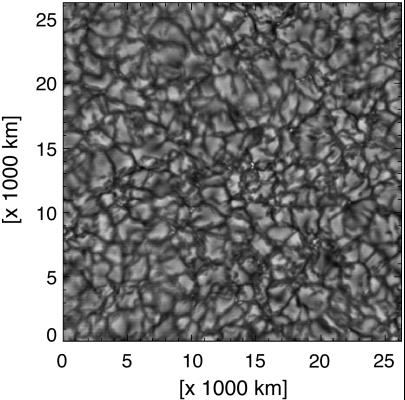
Caption: A black and white image of the granulation on the Sun.
The granules are hot rising convection cells that break up after about 10 minutes: they are about 1000 km in size scale (Se-148; Cox-364).
Between the granules, the gas sinks in intergranular lanes.
Credit/Permission: ©
Thomas Rimmele,
NOAO,
AURA,
NSF,
NOAO,
AURA,
before or circa 1998 /
NOAO/AURA Image Library Conditions of Use.
Download site: NOAO: im0381.html:
Solar granulation from the Vacuum Tower Telescope.
Image link: Itself.
Group Activity:
Form groups of 2 or 3---NOT more---and tackle
Homework 8
problems 5--10 on the Sun and
Sun layers.
Discuss each problem and come to a group answer.
Let's work for 5 or so minutes.
The winners get chocolates.
See Solutions 8.
-
The chromosphere
is a low density layer above the
solar photosphere that is about 10,000 km thick.
The chromosphere is illustrated in the figure below (local link / general link: sun_outer_layers_cartoon.html).
The chromosphere
temperature rises from
a low of about 4000 K to about 100,000 K at the top.
The lower cooler chromosphere is where the absorption line spectrum of the Sun forms.????
The hotter upper chromosphere has low density and an emission line spectrum which is NOT seen in integrated Sun spectra, but can be seen with special techniques.
Chromo means color and the name probably arises from the pink color the chromosphere would show to the naked eye.
But, the chromosphere is probably never seen by the naked eye under ordinary conditions. However, solar prominences which we discuss below are chromospheric in color (Se-160) and are visible during total solar eclipses.
Nowadays, the chromosphere is often observed from space through narrow filters centered on emission lines where it is bright.
The Solar and Heliospheric Observatory (SOHO, (1995--2022?) has provided some good extreme UV images from the 0.0304 micron line of singly-ionized He (AKA He II) which is the strongest singly-ionized He line. For example, see the figure below.
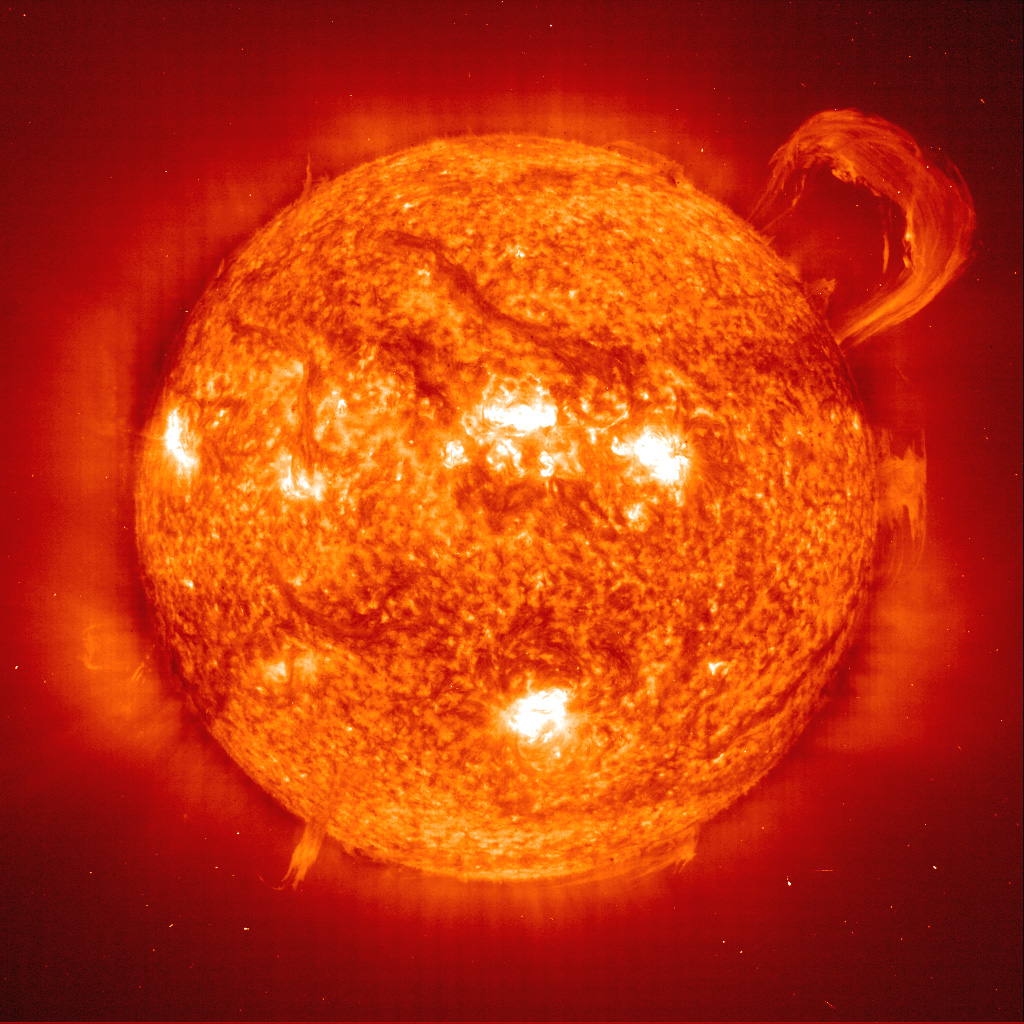
Caption: The Sun in a He II 0.0304 micron emission-line image.
The image is false color, of course.
0.0304 μm (microns) is far in the ultraviolet which begins going blueward of about 0.4 μm.
We are seeing the upper chromosphere/lower transition ??? region, NOT the solar photosphere. There is a nice prominence.
The arc shape is because the 60,000 K plasma follows magnetic field lines that rise up from the Sun and loop back to it.
Credit/Permission: NASA/SOHO (1995--2025?),
1999 /
Public domain.
Download site: NASA/SOHO: Prominence.
Image link: Itself.
-
Above the chromosphere is the
corona.
- never.
- at sunrise and sunset.
- during total solar eclipses.
- during annular solar eclipses.
-
Question: The
corona is visible to the
naked eye:
Answer 3 is right.
The corona is illustrated in the figure below (local link / general link: sun_outer_layers_cartoon.html).
The corona is
that milky white, tenuous, wispy gas seen around the
Sun in
total solar eclipses.
The wispy structure is because the ions tend to spiral around the magnetic field lines of the Sun. This is the effect of the magnetic force. We discuss magnetic fields further below.
The corona reaches from the chromosphere outward until it makes a transition into the solar wind. There is no sharp transition.
The corona can be traced out to 30 R_☉ (0.14 AU) (Se-151) which is still well within Mercury's mean distance to the Sun of 0.38709893 AU (Cox-294).
The corona's temperature is of order 10**6 K, and so it is much hotter than the solar photosphere and chromosphere.
But it is so dilute that it radiates much less than the solar photosphere.
It can be seen from Earth at eclipse times??? and from space at non-eclipse times by masking out the Sun. See the space image of the corona in the figure below (local link / general link: corona_soho.html).
Why are the outer chromosphere and
corona
hotter than the
solar photosphere?
Some mechanism pumps heat to them and it is NOT EMR from the photosphere. There is certainly enough photospheric EMR to do it, but the chromosphere and corona are too transparent to capture much of that EMR.
The most popular idea is that somehow magnetic field energy generated in the interior is then dumped as heat energy above the photosphere.
Now yours truly waves his hands here. Sometimes yours truly will just say magnetic field energy and NOT bother explaining---since yours truly doesn't know---how that energy gets converted into other forms.
There is certainly much more elaboration in the theory, but the definitive answer is NOT yet in (Wikipedia: Corona: Coronal heating problem).
See Solar corona videos below (local link / general link: solar_corona_videos.html):
-
As it goes outward, the corona morphs
into the solar wind.
- Where the Solar Wind Starts:
The solar wind mostly comes off from coronal holes: places where the Sun's magnetic field lines DO NOT close trapping the particles on closed loops (Ni-130).
Recall charged particles have a strong tendency to helix around magnetic field lines (see IAL 6: Electromagnetic Radiation), and thus if the those field lines return to the Sun, the particles have difficulty escaping to infinity.
A cartoon of the Sun's magnetic field lines is shown in the figure below (local link / general link: sun_magnetic_dipole_cartoon.html).
Additionally, there are complex magnetic field structures that are time variant.
There are permanent coronal holes at the Sun's axial poles (Ni-130) which are also its magnetc poles or close to them (???). Coronal holes can occur at other latitudes in a time dependent fashion (Ni-131).
The 3 figures below illustrate coronal holes and the start of the solar wind.
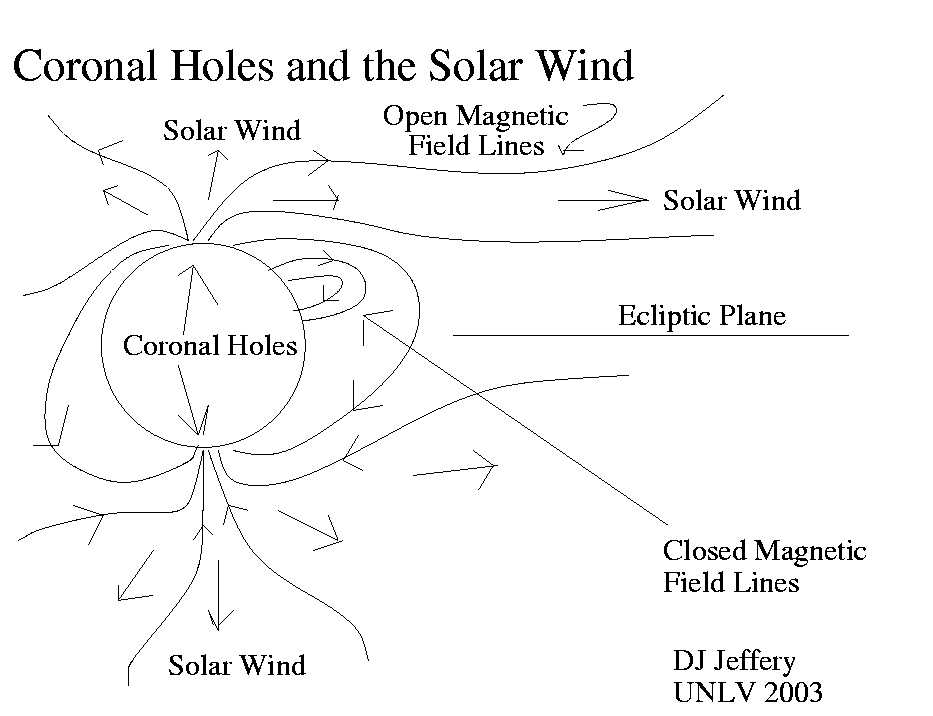
Caption: Coronal holes and the solar wind.
Credit/Permission: © David Jeffery, 2003 / Own work. Image link: Itself.
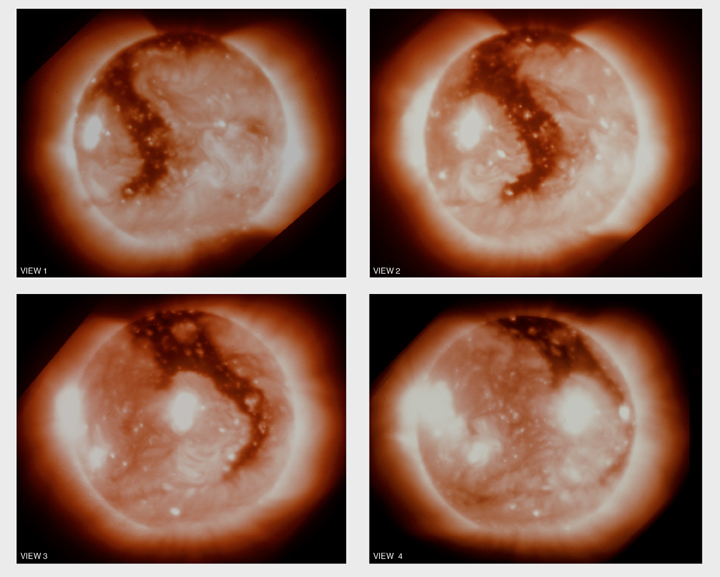
Caption: X-ray images of a boot-shaped coronal hole from Skylab 1973.
The images are from about 2 days apart. The rotation of the Sun is clear. Coronal holes seem to be magnetic field free areas or areas of outwardly open magnetic field lines in the corona that allow more free-streaming solar wind sort of like the nozzle of the hose whipped around.
Credit/Permission: NASA, 1973 / Public domain.
Download site: NASA. Alas, a dead link.
Image link: Itself.
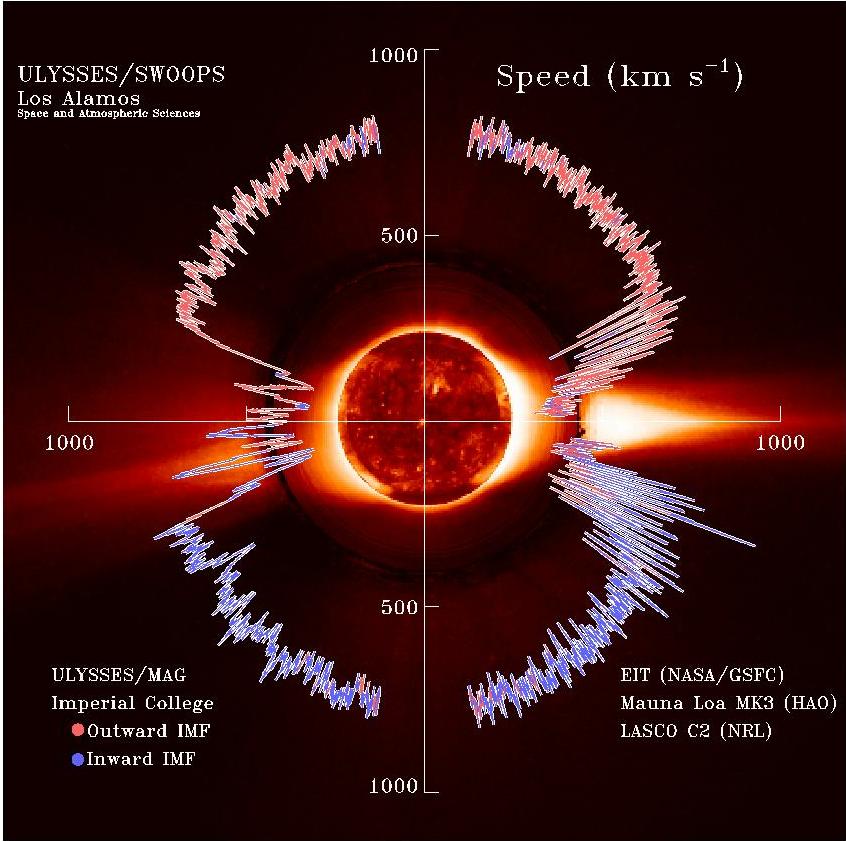
Caption: The Ulysses spacecraft's (1990--2009) map of solar wind speed.
This the wind speed close to the Sun yours truly guesses. Near the Earth, the speed is slower and near 400 km/s.
The diagram is NOT well captioned. Yours truly is guessing that the image is in the X-ray (and hence false color). IMF probably stands for "something magnetic field". Yours truly assumes that all these speeds were measured at the circular orbit of Ulysses, but yours truly can't track that information right now.
Credit/Permission: NASA, before or circa 2009 / Public domain.
Download site: NASA. Alas, a dead link.
Image link: Itself.
The mass loss rate by the solar wind isn't large: it's only about 2*10**9 kg/s (Se-152, but note the values need some correction).
If the rate kept steady---which it won't---how long until the Sun is exhausted?
First, let us convert to solar masses lost per year.
2*10**9 kg/s x (1 M_☉ / 2*10**30 kg) x (3*10**7 s / 1 year) = approx 3*10**(-14) M_☉/yr , Then from the ordinary exhaustion formula Amount/Rate = 1 M_☉ / 3*10**(-14) M_☉/yr ≅ 3*10**13 yr = 3*10**4 Gyr .-
Question: What is the estimated lifetime of the Sun?
- 3*10**4 Gyr.
- 1 Gyr.
- 10 Gyr.
Answer 3 is right.Since the Sun's lifetime is only about 10 Gyr, the Sun will NOT lose significant mass because of the current solar wind.
In its post-main-sequence life, the Sun will have stronger solar winds and will probably end up with only about 70 % of its current mass when it becomes a white dwarf (CK-329).
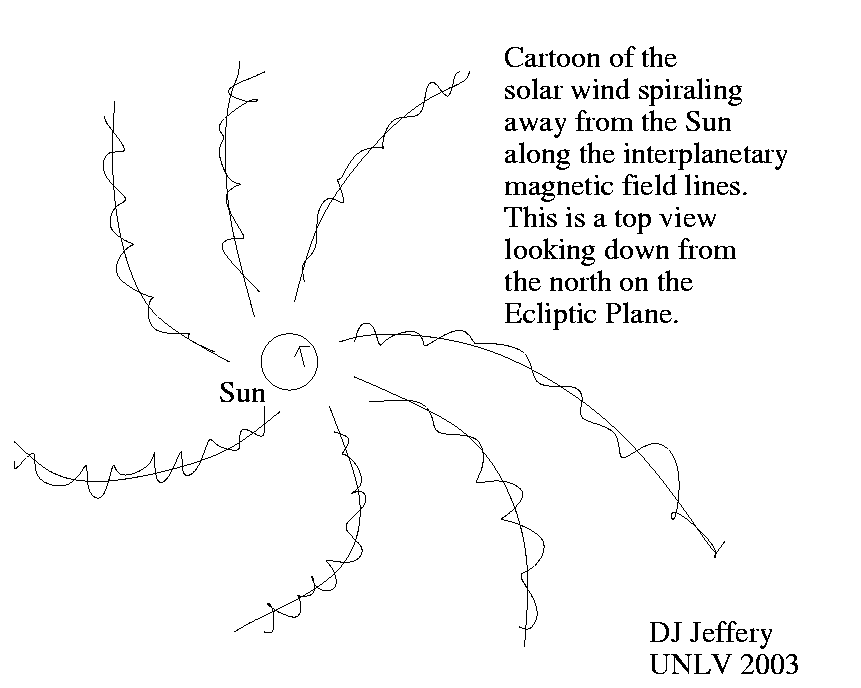
Caption: A cartoon of the solar wind as it flows through the Solar System. (Ze1994-287).
Since the solar wind consists mainly of ions (mainly of hydrogen (H, Z=1), and helium (He, Z=2)), it tends to helix around the spiraling magnetic field lines that extend from the Sun.
Credit/Permission: © David Jeffery, 2003 / Own work. Image link: Itself.
See Solar wind videos below:
-
Solar wind videos
(i.e., Solar wind
videos):
- Solar wind blows on Venus | 0:24: This seems to be just an animation, NOT observations in some wavelength band. But it was made by the European Space Agency (ESA), and so is probably authoritative. The solar wind seems to be blowing away some of the Venusian atmosphere (i.e., Venus's planetary atmosphere) which is unprotected by a strong magnetic field (see Wikipedia: Venus: Magnetic field and iron core). Despite appearances, the blowing effect must be relatively small since the Venusian atmosphere is still very thick at 4.6 Gyr after formation. Short enough for the classroom.
- Solar Wind Sonification! | 3:08: Just a collection of snazzy images and animations. Too long and unexplained for the classroom.
- The Heliopause:
The heliopause is explicated in the figure below (local link / general link: heliopause.html).
- The Solar Wind at the Earth and the Aurora:
At the distance of the Earth from the Sun, the solar wind speed is about 400 km/s. This is much faster than the low-Earth orbital velocity of 8 km/s. However, you wouldn't feel the solar wind if you were exposed to it. The ram pressure at 1 AU is typically (1 to 6)**(-9) Pa (i.e., N/m**2) (see Wikipedia: Solar wind: Pressure). Recall air pressure at sea level is about 1 standard atmosphere (atm) = 101325 Pa exactly ≅ 10**5 Pa).
The Earth is protected from the solar wind mostly by the Earth's magnetic field: a distorted dipole field which forms what is called the magnetosphere---although it isn't spherical. See the figure below.
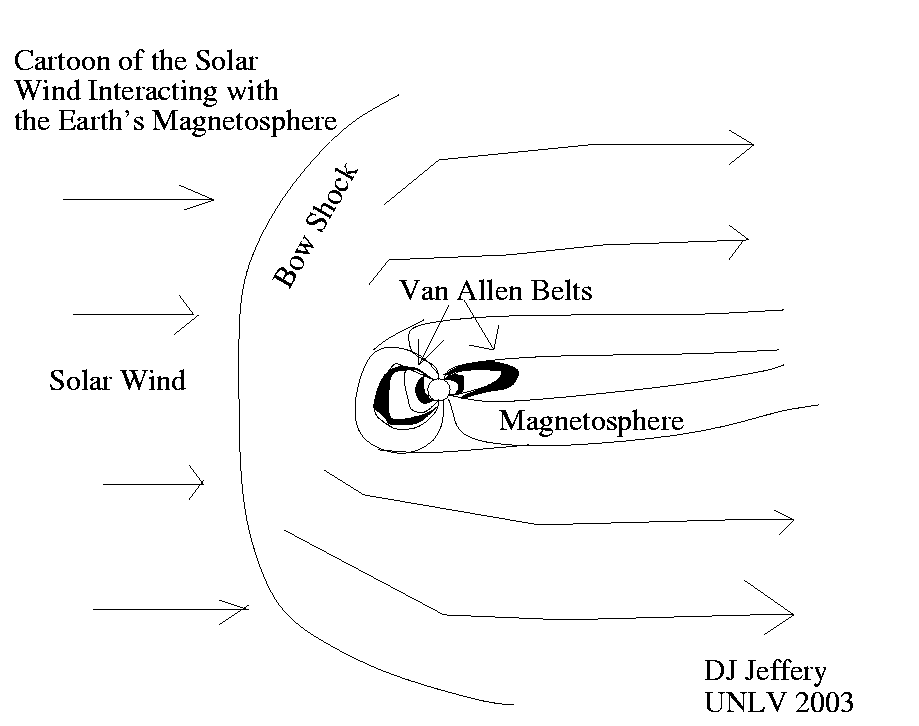
Caption: A cross section diagram of the solar wind interacting with the Earth's magnetosphere.
Credit/Permission: © David Jeffery, 2003 / Own work. Image link: Itself.
The solar wind particles mostly can't force their way to the Earth. The Earth's magnetic field tends to make them slide around the magnetosphere.
The protection by the magnetosphere is probably necessary. The solar wind probably blew away part of Mars's atmosphere (Se-480).
The solar wind particles can also act as dangerous ionizing radiation for life and electronic systems. The magnetosphere largely protects astronauts and satellites, but large solar storms (see below) can cause solar wind particles to penetrate the magnetosphere and be more dangerous than ordinarily. See UCAR's Effects at Earth of Space Weather Events.
-
Yours truly thinks
the cosmic rays from
outside the solar system are more of a radiation hazard to life than
solar wind particles because they have higher energy.
See Health threat from
cosmic rays.
Yours truly needs to look into this a bit more.
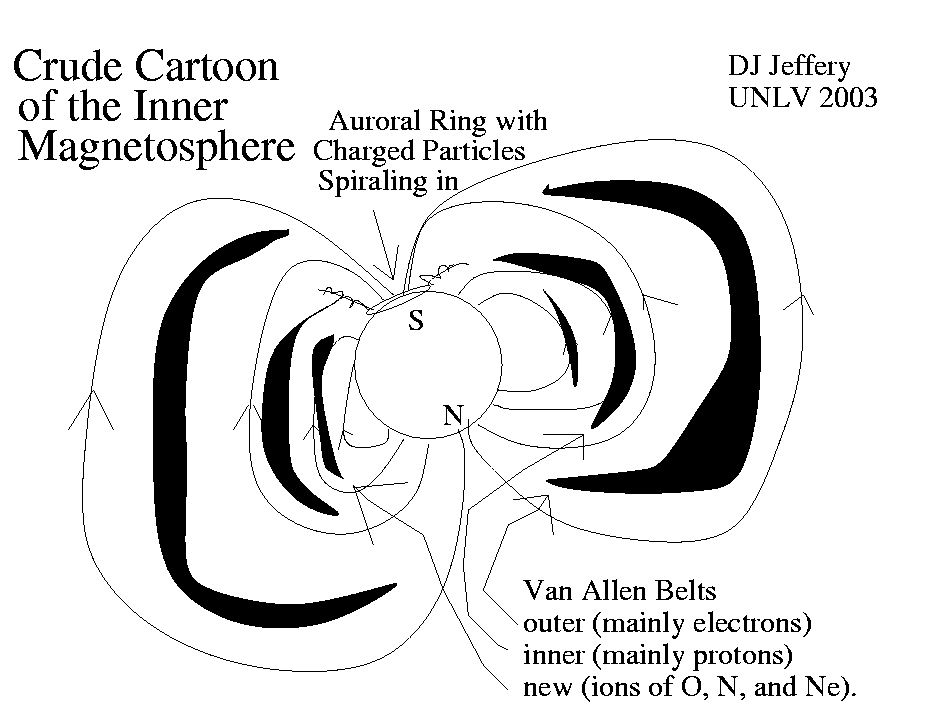
Caption: A very, very crude cross section diagram of the inner magnetosphere of the Earth (see also Earth's magnetosphere).
Since it is a cross section diagram, you have to envisage the magnetic field lines and Van Allen radiation belts as having approximate cylindrical symmetry around the Earth's axis.
Credit/Permission: © David Jeffery, 2003 / Own work. Image link: Itself.
Some of the solar wind particles can helix into the Earth's atmosphere near the poles. The tend to come down in a ring called an AURORAL RING.
In fact, during strong gusts of solar wind (e.g., coronal mass ejections: see section Coronal Mass Ejections below), the particles can helix in at lower latitudes and one can get aurora there and strong aurora in many places.
Through a rather complex process, the solar wind particles result in currents in the Earth's atmosphere of ions and ions and electrons.
The collisions of the of ions and ions and electrons of the currents with with air molecules excites air molecules (i.e., gives them internal energy).
When the air molecules de-excite they emit light. This is same process as in a neon light that generates ultraviolet light that is then by another process converted in to visible light.
The result in the atmosphere is the aurora.
The aurora, in fact, have an emission line spectrum as illustrated in the figure below (local link / general link: /noaa_aurora_line_spectrum.html).
-
Question: Can the aurora
ever be seen in Las Vegas?
- Never.
- Frequently.
- Rarely.
Answer 3 is right.My late colleague at UNLV Lon Spight remembers seeing an aurora circa 1970, but yours truly thinks they must have been seen more recently than that.
For examples of the aurora, see the figures below.
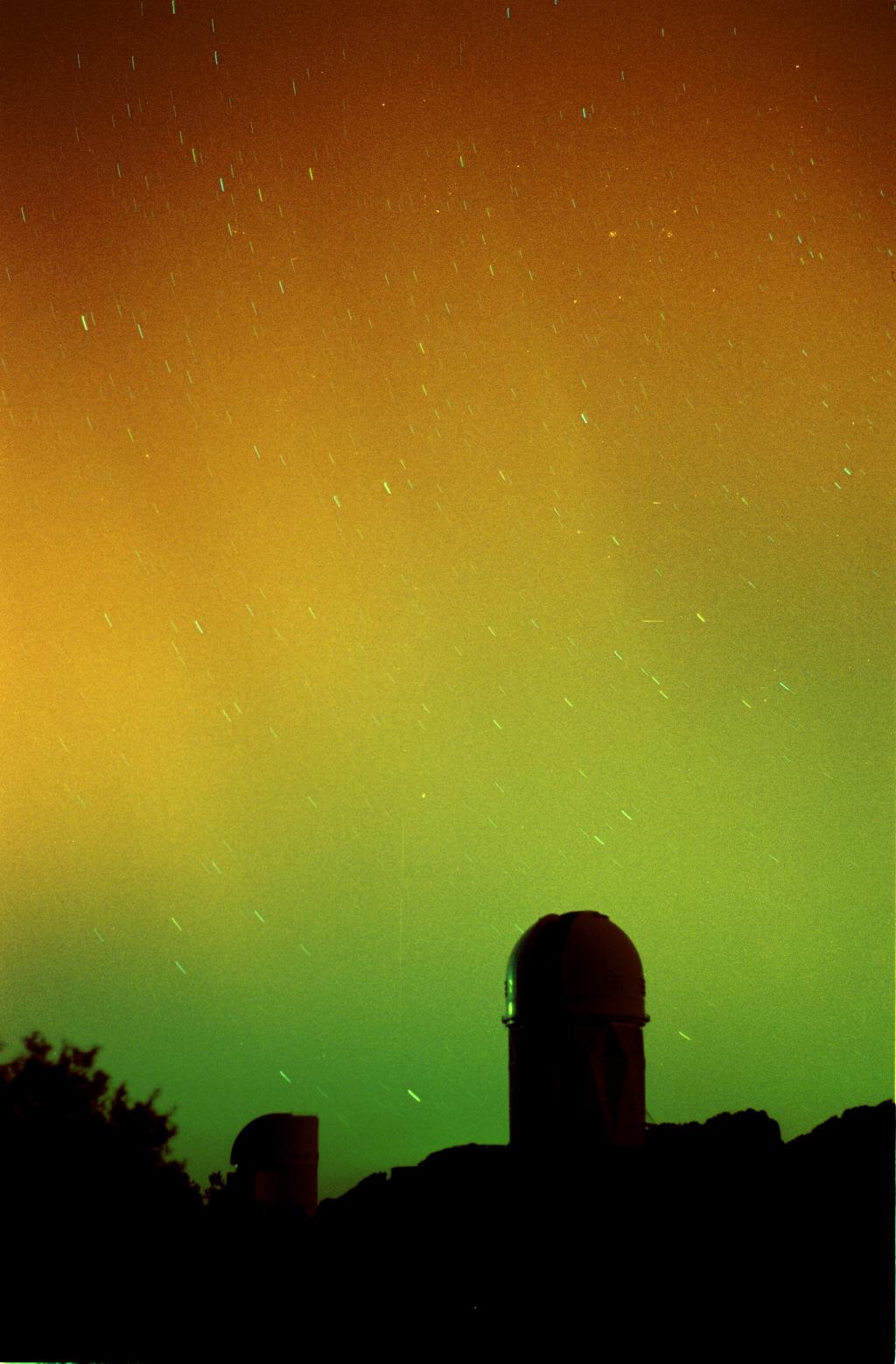
Caption: The aurora at Kitt Peak, Arizona, 2001mar28.
The aurora in Arizona was associated with a coronal mass ejection from the Sun. Coronal mass ejections are massive gusts of the solar wind often accompanying solar flares.
The image is long-exposure as one can see from the finite length star trails. Long-exposure means that the aurora is brighter than the eye would see. It also means that the aurora are smeared out a bit and do NOT have the whispy appearance due the charged particles helixing in the Earth's magnetic field.
Credit/Permission: © NOAO, Adam Block/NOAO/AURA/NSF (Minimum credit line, 2001 / NOAO/AURA Image Library Conditions of Use.
Download site: NOAO: im0664.html. Image link: Itself.
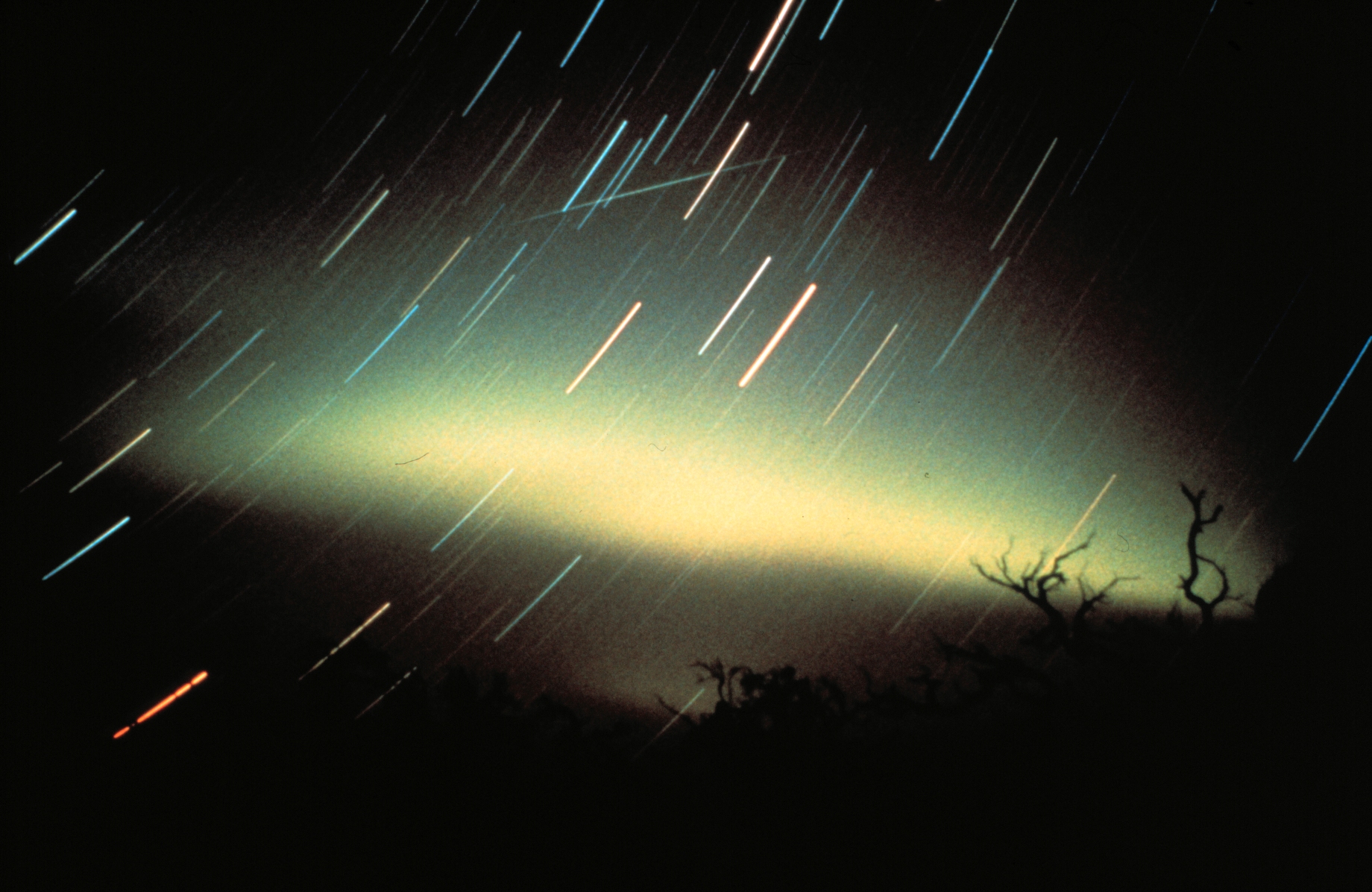
Caption: The aurora australis.
The image is long-exposure as one can see from the finite length star trails. Long-exposure means that the aurora is brighter than the eye would see. It also means that the aurora are smeared out a bit and do NOT have the whispy appearance due the charged particles helixing in the Earth's magnetic field.
This aurora event may have pretty dim to the naked eye.
Credit/Permission: National Oceanic and Atmospheric Administration (NOAA), National Geophysical Data Center, before or circa 2003 / Public domain.
Download site: NOAA: Image ID: wea02007, Historic NWS Collection; Location: Kangaroo Island, South Australia; Photographer: David Miller. Alas, a dead link.
Image link: Itself.
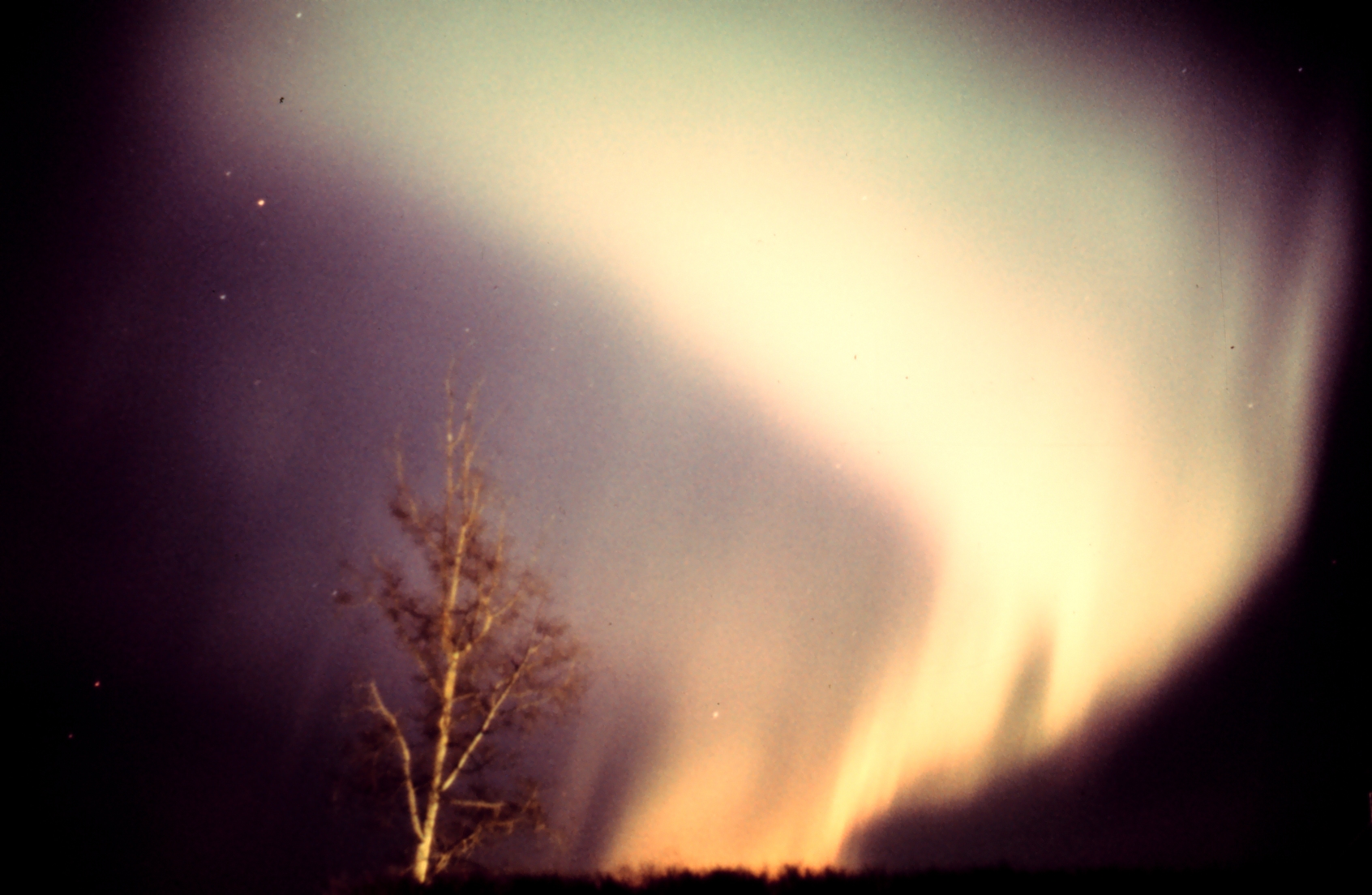
Caption: Aurora borealis in vicinity of Anchorage.
Since the stars are NOT trails, this must have been a short exposure---maybe even a snapshot.
So this aurora event would have bright to the naked eye.
Credit/Permission: National Oceanic and Atmospheric Administration (NOAA), National Geophysical Data Center, 1977 / Public domain.
Download site: NOAA: Image ID: wea01013, Historic NWS Collection; Location: Anchorage, Alaska; Photo Date: 1977; Photographer: Doctor Yohsuke Kamide, Nagoya University; Source: Collection of Dr. Herbert Kroehl, NGDC. Alas, a dead link.
Image link: Itself.
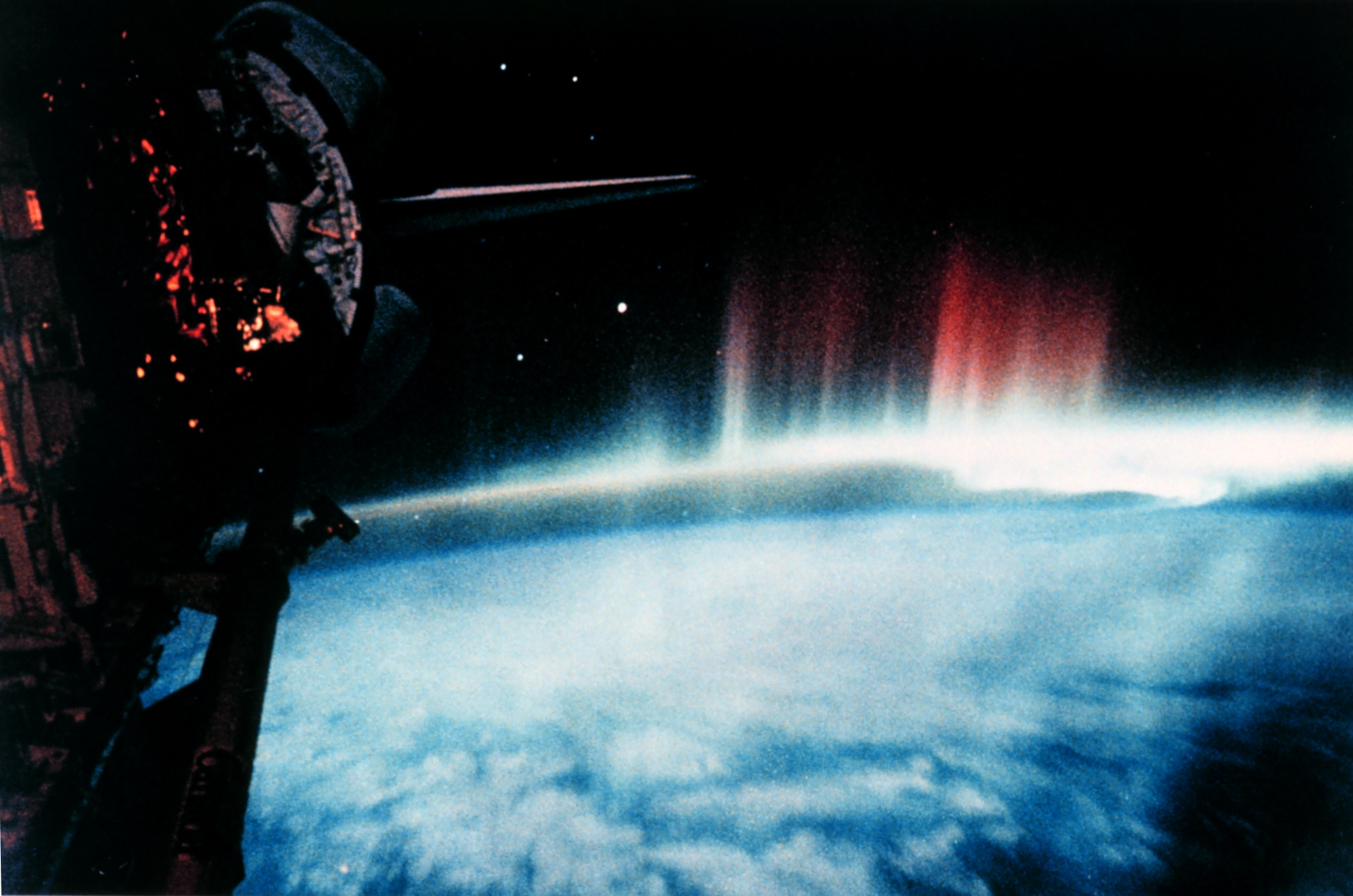
Caption: From The Other Side of the Sky as Arthur C. Clarke (1917--2008) would say---the aurora from the Space Shuttle.
Credit/Permission: National Oceanic and Atmospheric Administration (NOAA), before or circa 2003 / Public domain.
Download site: NOAA: Image ID: wea01034, Historic NWS Collection. Alas, a dead link.
Image link: Itself.
Caption: A 360 degree panorama at the South Pole with Constellations with aurora. A nifty gigapan from the deep, deep south:
The military is very keen on developing snapshot gigapans for reasons of peeping into windows (see Can You See Me Now? A camera with a unique, spherical lens may bring single-shot gigapixel cameras closer to reality, 2011 March).
Credit/Permission: © Jeremy Johnson, 2009 / No permission.
Image link: 360 degree pano South Pole with Constellations.
Image link: Placeholder image alien_click_to_see_image.html.
To further illustrate aurora, see the auroral oval (AKA auroral ring) in the figure below (local link / general link: auroral_oval_film.html).
The solar wind is an expanding stream of protons (ionized hydrogen atoms) and electrons and other particles coming off the corona.
We will NOT go into the causes of the solar wind: they may arise from magnetic effects????, but the instructor admits to plain ignorance on the subject.
-
Solar activity is essentially solar weather.
But unlike the Earth's weather, solar weather is dominated
by magnetic effects. But we won't go into the causes of
solar activity which are NOT fully understood and are certainly
too complex for our course.
The Sun has an overall magnetic field that is dipolar with a north and south pole like a bar magnet and like the Earth (Ni-130). A cartoon of the Sun's magnetic field lines is shown in the figure below (local link / general link: sun_magnetic_dipole_cartoon.html).
The polarity of the Sun's field reverses every 11 years on average
for an overall cycle of 22 years on average
(HI-300;
FMW-296).
The reversals occur at the solar minima of the
solar cycle????.
-
The Earth also has magnetic field reversals that occur intervals
of a few hundred thousand to a few million years
(HI-300).
What causes the magnetic field of the Sun?
Well the Sun is a plasma in its interior: i.e., all the particles are charged. It is also rotating differentially and has convection.
Somehow, in way that is NOT fully understood yet, large electric currents must form. Electric currents generate a magnetic field: this is just a fundamental fact. And this must be what happens in the Sun.
The process of generating a magnetic field this way is called the DYNAMO EFFECT (Se-157).
In addition to the main dipole magnetic field structure their are smaller time varying structures associated with sunspots mainly.
For further insight, see the Solar atmosphere videos below (local link / general link: solar_atmosphere_videos.html):
Form groups of 2 or 3---NOT more---and tackle
Homework 8
problems 11--18 on
granules,
the solar atmosphere,
the Solar photosphere,
the chromosphere,
the corona,
and
the solar wind.
Discuss each problem and come to a group answer.
Oh, 5--10 minutes.
See Solutions 8.
The winners get chocolates.
EOF
Group Activity:
-
Sunspots
have probably been occasionally noticed going back into prehistory.
- Introduction to Sunspots:
For an introduction to sunspots, see the figure below (local link / general link: sunspots_intro.html).
- The Solar Cycle:
For an explication for the solar cycle (11 years on average; 9 to 14 year range) and its role in sunspot activity, see the figure below (local link / general link: sunspots_solar_cycle.html).
- The Early Telescopic History of Sunspots:
For a bit of history of early telescopic sunspot observations, see the figure below (local link / general link: sunspots_history.html).
- The Solar Cycle:
Certainly, they were observed and recorded for thousands of years in China (SRJ-357).
-
They are NOT all that hard to see. If the Sun is covered by
a mist or smoke, they can be seen with the
naked eye---but this
is NOT a safe thing to do.
You shouldn't be paranoid about catching glimpses of the Sun: we do this all the time. But the damage over a lifetime may be cumulative, and so one should avoid viewing the Sun.
-
In the vicinity of sunspots are DARK FILAMENTS: comparatively
dark narrow sinuous string-like regions in the
solar photosphere---but
I can't find a good image of one.
They stretch for up to 100,000 km and are locations of zero magnetic field between regions of opposite magnetic field lines (PF-186).
-
The Sun's diameter is 1,400,000 km, and so the filaments can
look really long on the disk of the Sun.
The arc shape is determined by magnetic field lines. The charged particles helix around the field lines tracing the arc.
The special strong time-varying magnetic field structure that shapes a prominence must be determined by internal currents and energy sources in the Sun---and that is all I'm going to say about cause.
Prominences in the visible are pink or red from H alpha emission and resemble chromospheric conditions. They are of order 100 times denser than the corona and have temperatures of order 10,000 K (Ni-126).
They are only seen by the naked eye during total solar eclipses.
A QUIESCENT PROMINENCE can arise in hours and last weeks or months (Se-160).
A giant prominence is illustrated in the figure below.
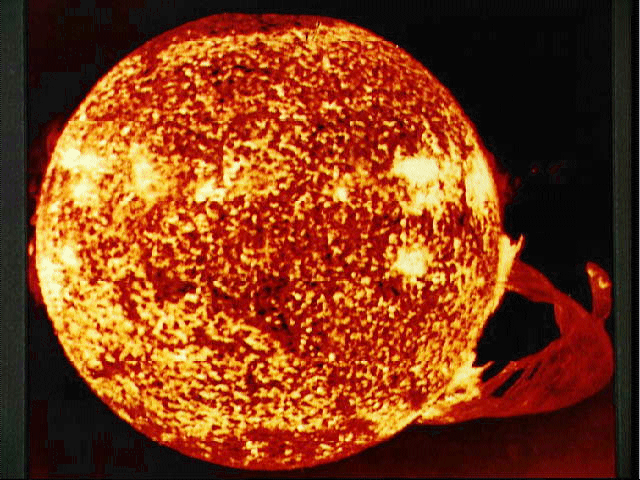
Caption: The Sun with a giant prominence.
One of the most spectacular prominences ever seen. From Skylab, 1973dec19. The image is in the UV and hence is false color.
Credit/Permission: NASA,
1973 /
Public domain.
Download site: Yours truly has lost track of the download site, but
the image appears in Se-161.
Image link: Itself.
There are also ERUPTIVE PROMINENCES that occur on the order of hours (???) and eject matter into space.
An ERUPTIVE PROMINENCE is illustrated in the figure below.
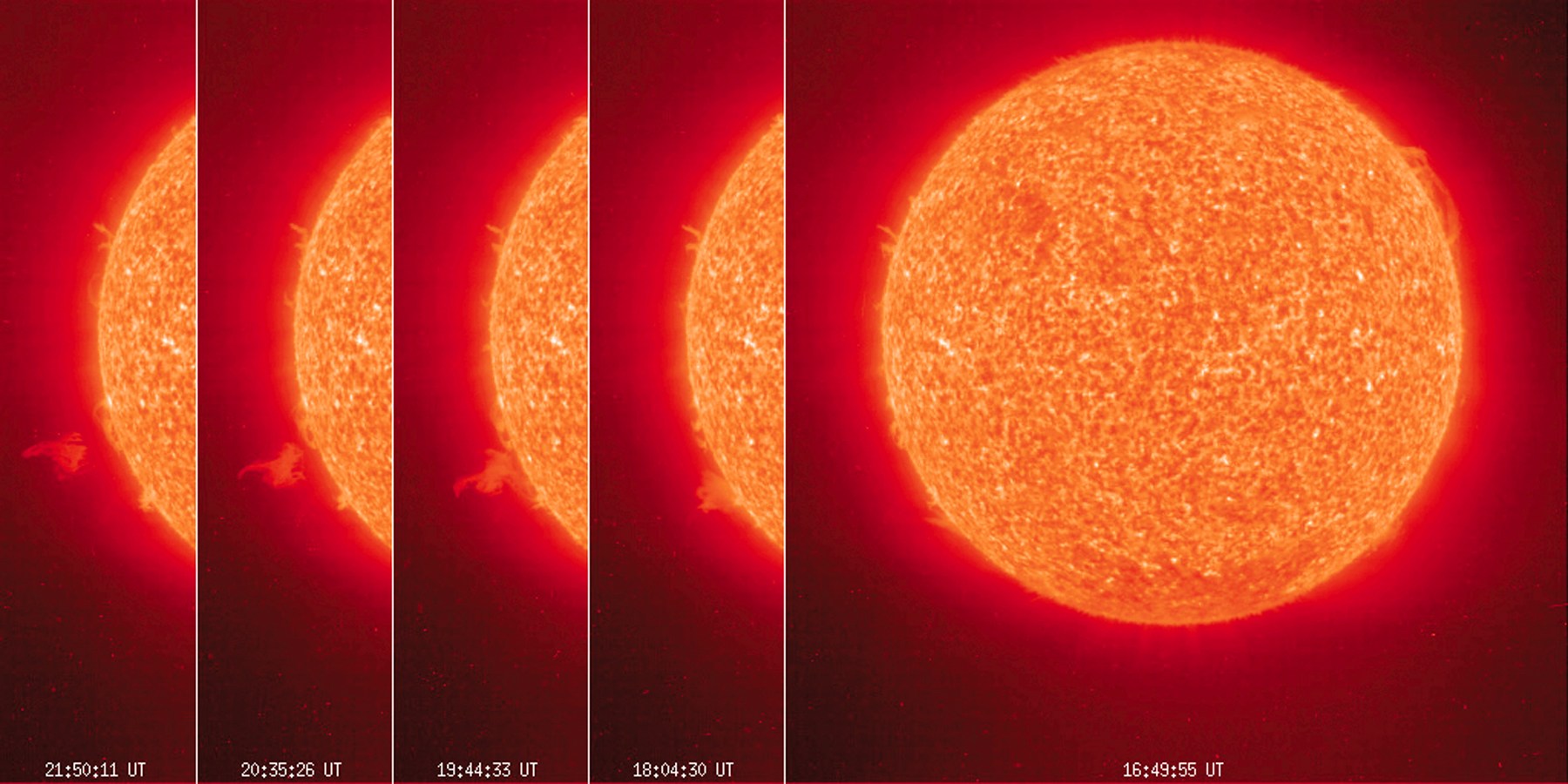
Caption: A UV series of images of the Sun with an eruptive prominence.
An eruptive prominence is NOT the same as a coronal mass ejection: it is probably much less powerful. The blob can still make it to Earth. This is an extreme ultraviolet image from the SOHO spacecraft (1995--2022?), and thus it is false color image
Credit/Permission: NASA,
before or circa 2003 /
Public domain.
Download site: NASA: GPN-2002-000120.html.
Alas, a dead link.
Image link: Itself.
-
FLARES are enormous explosions that are much stronger than eruptive prominences.
FLARES are believed to be caused by MAGNETIC RECONNECTION. This is when tangled magnetic field lines quite suddenly become unstable and reform in a simpler pattern.
When they do this they somehow dump magnetic field energy as heat energy, EMR, and kinetic energy.
The analogy is often made that MAGNETIC RECONNECTION is like an elastic band snapping: potential energy stored in the stretched configuration is suddenly released as kinetic energy.
A solar flare is illustrated in the figure below.
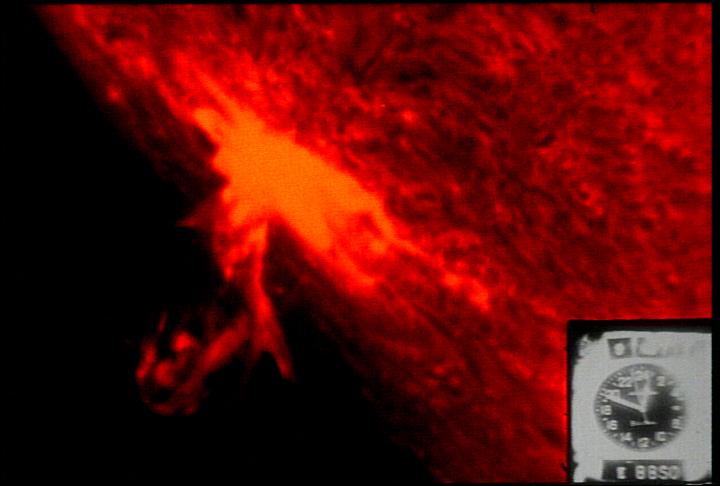
Caption: A solar flare seen on the limb of the Sun, 1971 Oct10.
The solar flare is being observed in the Hα line (i.e., the red emission line of hydrogen).
Credit/Permission: NASA,
1971 /
Public domain.
Download site: NASA: flares.htm .
Alas, a dead link.
Image link: Itself.
10**25 J = 2.5 * 10**9 megatons (1 megaton TNT = about 4*10**15 J)and temperatures can reach 5*10**6 K which is much hotter than the chromosphere or solar photosphere.
-
Coronal mass ejections (CMEs)
are huge bubbles of coronal gas ejected from
the Sun within a few hours.
- What Coronal Mass Ejections Look Like:
A false-color image of a coronal mass ejection is shown in the figure below.
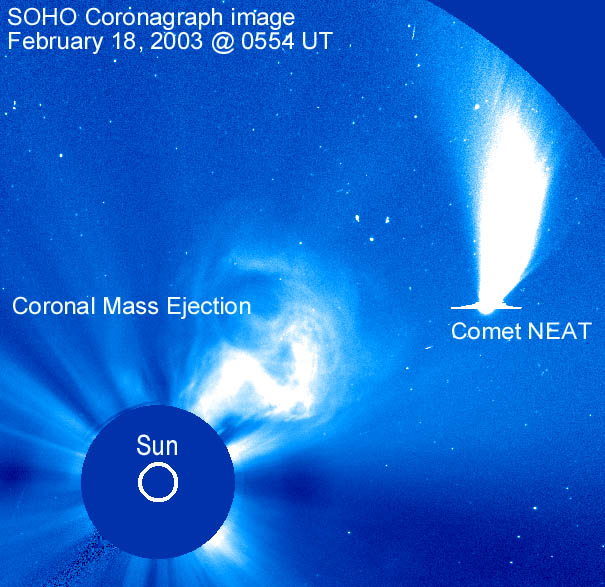
Caption: SOHO (1995--2025?) picture of a coronal mass ejection with Comet NEAT.
This is a 2003 Feb18 image. The caption gives no information on wavelength, but I'd guess the visible band since we see stars and the corona looks white. The Sun is masked.
Credit/Permission: NASA, 2003 / Public domain.
Download site: NASA: SOHO mission.
Image link: Itself.
See Solar corona videos below (local link / general link: solar_corona_videos.html):
- EOF
- When Coronal Mass Ejections Hit the Earth:
If coronal mass ejections hit the Earth in the form of strong gusts of solar wind, we can get strong aurora as mentioned above in subsection The Solar Wind at the Earth and the Aurora.
Such strong gusts can also cause geomagnetic storms: i.e., cause the Earth's magnetosphere (AKA Earth's magnetic field) to vary rapidly in time.
A cartoon of a coronal mass ejection hitting the Earth is shown in the figure below.
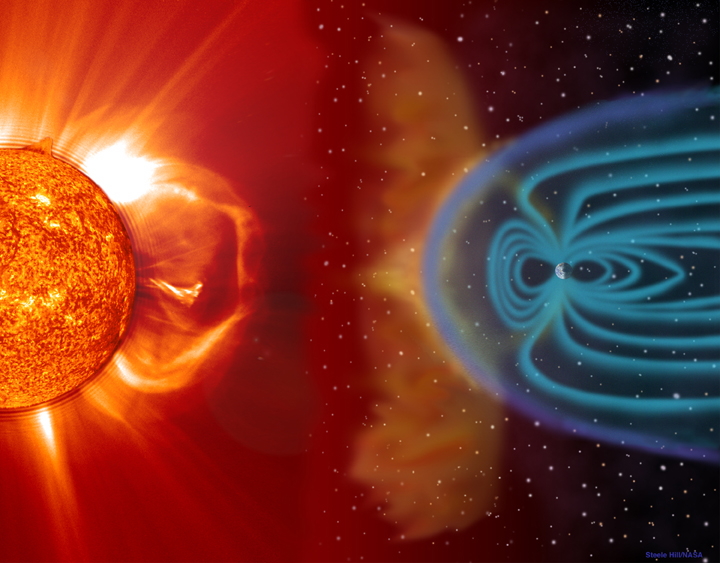
Caption: A composite/artificial image of a coronal mass ejection.
The image is not-to-scale.
Coronal mass ejections are the biggest kind of solar wind effect on the Earth. They can cause severe magnetic storms on Earth.
Credit/Permission: NASA, 2003 / Public domain.
Download site: NASA: MSFC-0201490.html. Alas, a dead link.
Image link: Itself.
Geomagnetic storms can cause blackouts (AKA power outages).
A fundamental effect of electromagnetism is that a time-varying magnetic field causes an electromotive force (emf) (via Faraday's law of induction) which will drive an electrical current in an electrical conductor. This effect is the basis of electrical generator, and so is the basis of the electrical grid.
In a geomagnetic storm Earth's magnetic field under goes rapid variations over large distances over the Earth Now neither of Earth's magnetic field nor the variations are large, but they act over large distances. There is thus a cumulative large and unsafe emf in electrical power transmission wires. The large electrical currents induced can burn out electrical transformers which are everywhere in the electrical power grids. The big ones are in fenced-in areas that one frequently sees.
Now if electrical transformers burn out, the electricity stops and there is a blackout. Powerful geomagnetic storms can cause major blackouts.
- Super Geomagnetic Storms:
A super coronal mass ejection that impacts the Earth could cause a super geomagnetic storm that could potentially crash electrical power grids worldwide.
It could take months or year to repair all the electrical transformers and other damage. A main difficulty is that repair procedures themselves depend on having electrical power grids.
There would be other effects too.
See the articles Solar storm researchers prepare for the 'big one' with new urgency, Tracey Regan (2016), BBC: Lagrange: The early warning satellite: Design call for 'solar sentinel' mission, Jonathan Amos (2018), and Solar storms have influenced our history --- an environmental historian explains how they could also threaten our future Dagomar Degroot (2025).
A massive electrical power grid failure caused by a super geomagnetic storm would be a massive worldwide catastrophe---except for those lucky people who don't depend on electrification for anything---i.e., the world's last hunter-gatherers.
The rest of us would be like Puerto Rico after Hurricane Maria (2017)---but a lot worse.
Could such a super geomagnetic storm happen?
Yes. The super CMEs that cause them are NOT very rare: they just usually do NOT hit the Earth.
In fact, super geomagnetic storm did happen occasionally in the pre-electrification world without anyone noticing---except for the great aurora.
The largest known pre-electrification one may have been the Year 774--775 CE carbon-14 spike event. See also Jonathan O'Callaghan 2021, SciAm, "Solar 'Superflares' Rocked Earth Less Than 10,000 Years Ago---and Could Strike Again".
However, one super CME did happen in 1859 when electrification was just beginning and of minor significance to society---there was just a little bit of electrical telegraphy.
This super geomagnetic storm was the Solar storm of 1859 (AKA the Carrington event).
We had a near miss in 2012 July. See the article Near Miss: The Solar Superstorm of July 2012, Tony Phillips (2014).
Civilization was saved---for now.
See the Geomagnetic storm videos below (local link / general link: geomagnetic_storm_videos.html):
- EOF
But can we see super CMEs coming early enough? Not yet, but people are working on it ...
The European Space Agency (ESA) is planning the ESA Vigil spacecraft (est. 2031--2036?) which will study solar weather (and space weather generally) and in particular give the early warning of CMEs, particularly dangerous super CMEs. ESA Vigil will be at Lagrange point L5. There is also planned a complementary mission by NOAA NESDIS to put a spacecraft at Lagrange point L1 (see Wikipedia: ESA Vigil: Project history).
The Lagrange points in general are explicated in the figure below (local link / general link: lagrange_points.html).
- When Coronal Mass Ejections Hit the Earth:
Magnetic effects seem responsible for coronal mass ejections---and that is all we'll say about cause.
Coronal mass ejections often accompany solar flares or eruptive prominences, but can occur in the absence of either.
